Well, the price is less.
Nissan’s Leaf electric car is now the least expensive electric car available in the United States – and the only EV that starts under $30k. Everything else that’s electrified has a base price well over $30k.
As the Leaf did, too – last year.
This year, it costs $4,200 less to start vs. last year’s Leaf (which stickered for $31,600 to start vs. $27,400 to start, this year).
This is not a small thing.
Unfortunately, Nissan’s little EV doesn’t go any farther this year – just 149 miles, like last year . . . unless you pay well over $30k for one with a stronger battery.
Which brings us back to the same two problems with the Leaf . . . and with electric cars, generally.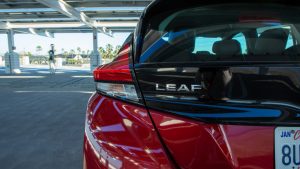
What It Is
The Leaf is the one new electric car you can buy that doesn’t cost over $30,000 to start.
That makes it the only EV that isn’t cost-competitive with entry-luxury cars, the cost of which renders their argument as economic alternatives to gasoline-powered cars more than a little silly.
Dimensionally, it can be compared with Nissan’s Versa sedan as both are about the same length overall and similarly shaped – though the Leaf has more cargo-carrying capacity because it’s a hatchback while the Versa is a sedan with a smaller trunk.
The biggest difference, of course, is that the Leaf is electrically propelled while the Versa has a conventional gasoline-burning engine.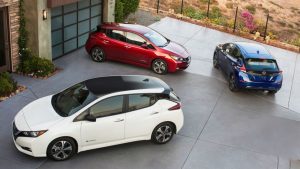
Well, there are some other differences to consider, too – both of them a function of their differing means of propulsion.
The 2022 Leaf’s base price is $27,400 – vs. $14,980 for the Versa. At these prices, the Leaf can travel about half as far as the Versa – 149 miles vs. about 300 miles for its non-electric sibling. The Leaf can be “fueled” at home – by plugging it into a household 120 volt or 240 volt (doubled up) outlet, but the Versa can be back on the road after less than five minutes – as opposed to the several hours it takes to instill significant recharge into any EV’s battery pack at home. 
If you want to go farther than 149 miles on a charge, Nissan offers a “Plus” version of the Leaf, which can get you 226 miles down the road.
Maybe.
That’ll cost you $32,400 to start.
A top-of-the-line Leaf SL Plus stickers for $35,400. This one comes with the stronger battery and more range, plus leather trim as well as a home-type heat pump for the cabin that warms the car more efficiently than a resistance heater (similar to baseboard heating in a home) and a premium seven speaker Bose audio system.
In addition to a lower base price, all versions of the ’22 Leaf come standard with Level 3 charging capability – meaning you can plug them into commercial high-voltage (400-900 volt) “fast” chargers available outside the home – in addition to the 120V and 240 V outlets available in private homes.
This reduces the time to recover 80 percent charge from several hours or more to 30-45 minutes or so.
But keep in mind that you cannot “fast” charge any EV at home – because private homes aren’t wired for it. That means driving to the “fast” charger – and waiting there, for the car to recharge.
There is also a new “semi-autonomous” ProPilot Assist feature that keeps the car in its travel lane with minimal driver input. 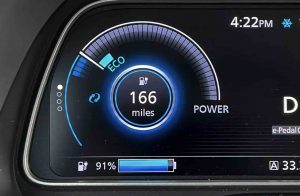
What’s Good
It’s a few thousand less than it was – to start.
About twice as much available cargo space vs. Chevy Bolt.
Newly standard “fast” charge capability gets you going again, sooner.
What’s Not So Good
Lower price doesn’t come with increased range.
“Fast” charging is still glacially slow relative to fueling up a non-EV.
Don’t forget to factor in the cost of updating your house’s wiring, if you’re not wired for 240 volt charging – as well as the cost of replacing the Leaf’s battery, eventually.
One thing about electric cars vs. non-electric cars that will make shopping for an EV easier is there’s less to consider. All EVs have battery packs and electric motors – and there’s not much difference between them.
One may be larger – or smaller – than another. Or more – or less – powerful. But it’s nothing like the difference between a turbocharged in-line four cylinder engine and a V8. Also, most EVs don’t have transmissions – the electric motor directly drives the wheels – so no need to ponder the pros and cons of a manual vs. and automatic or a dual-clutch automatic vs. a continuously variable (CVT) automatic).
The main things to ponder with an EV are – how far can it go and how long does it take to get going, again?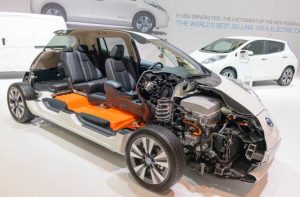
With the Leaf, you have two choices to ponder regarding the first.
The base trim that costs $4,200 less this year than last year comes with a 40 kilowatt-hour battery pack and a 147 horsepower electric motor, driving the front wheels. This combo has a maximum range of about 149 miles – making this version of the Leaf the electric car with the shortest leash of any new EV.
That’s the price you pay for not spending more than $30k.
Plus versions of the Leaf get a stronger, 60 kilowatt-hour battery pack and a more powerful 214 horsepower electric motor, also driving the front wheels. Equipped with this combo, the Leaf can go about 226 miles.
The cost of that additional 77 miles of range is $5,000 – the difference in price between the base Leaf and the Plus Leaf.
To put that in some cost-benefit perspective, a non-electric Versa can travel 152 miles farther than the Plus version of the Leaf – approximately 378 highway miles on 10.8 gallons of gas – for $17,420 less.
Or put another way, one could buy two Versas (at $14,980 each) for less than the cost of one Leaf Plus.
On The Road
EVs have several things going for them, leaving aside the debatable business about their environmental superiority to non-electric cars (which is premised on a debatable environmental problem).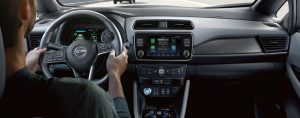
Leaving that aside, there’s no denying EVs are quieter than non-electric cars – in fact, EVs are silent when not moving, even though they are running.
Nor that their throttle response is more immediate, notwithstanding they haven’t got throttles.
Combustion engines have to run – must rev – to make power. That means it takes a moment or so to make power. Which means even if they make a lot of power, it’s not as right now power as you get in an EV, because electric motors make their maximum torque immediately.
That’s why the Leaf – even the one without the Plus upgrade – is quicker-feeling as well as actually quicker than most non-electric economy cars like its sibling, the Versa. The latter needs almost ten second to get to 60 MPH – vs. in the sevens for the Leaf.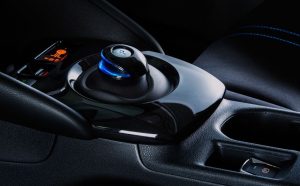
The electrically-motivated Leaf also has more immediate power for bobbing and weaving in traffic. Which is also a function of the immediacy of the power delivery from the motor to the wheels, directly – without any intermediary (i.e, a transmission). Eliminating the middle man – so to speak – also eliminates the shifts. So there’s no delay in between gear swaps.
Instead, it just goes.
But it doesn’t go very far. 149 miles is less than half as far as almost any non-electric car can go and much less far than other electric cars can go, too.
And it goes less than advertised – given the limitations imposed by charging scenarios.
It’s no big risk to run a non-electric car to near-empty because it’s so easy and so fast to refuel to full, practically anywhere. But you run the risk of a long wait – at least 30-45 minutes, at a “fast” charger – if you run out of range in an EV.
The wait will be much longer if you run out of range before you make it to a “fast” charger.
Range also varies greatly in an EV depending on usage – and more so than in a non-electric car. The touted maximum range depends for its realization on a light right foot – and moderate temperatures, outside. The updated Plus model has a new heat pump system that draws less electricity than a resistance-type heater (like the space heaters you plug into a wall outlet) but you’re still drawing electricity to make heat, which saps range – as is the case when you turn on any electrically-powered accessory in the Leaf or any other electric car.
Temperature matters more, too – and not only because if it’s cold out (as it was during this test drive) you will be more likely to turn on the heat – as well as the lights, probably, because when it’s cold it gets darker, sooner. Colder outside temps also reduce range because cold impinges upon battery performance (it is also necessary to keep the battery heated when it’s cold outside, which uses electricity, too).
The tested Leaf S had a real-world leash of about 100 miles – leaving a 20-something mile safety margin on the range indicator – to avoid the very real risk of rolling to a stop several miles shy of a place to plug in and thus have to wait . . . by the side of the road, for a tow truck or a charge truck.
The car’s modest range can be ok – if you generally don’t need to travel farther than 100 miles per trip and can plug in – conveniently – at home and be sleeping or doing some other needful thing while the Leaf (or any EV, for that matter) recovers its lungs.
Or rather, its volts.
But it still seems silly – if not bizarre – to even entertain such a thing when a non-electric car that costs about half as much – such as the Versa – can go more than twice as far and takes a fraction as long to get going again, practically anywhere.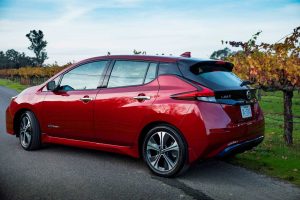
At The Curb
The Leaf looks like what it isn’t – which is to say, like an inexpensive, compact-sized economy hatchback.
That would be the Versa.
However, the Leaf is more practical in some ways than the Versa – which works well as a commuter car but not as well as a family car, on account of its small (14.7 cubic foot) trunk and its tight (31 inches of legroom) back seats.
On these two counts the Leaf excels, with 23.6 cubic feet of cargo capacity behind its second row and 30 cubic feet if you fold them down. There’s also 33.5 inches of backseat legroom, which – combined with the cargo room – makes the Leaf viable as a primary or even only car for a small family.
Provided you don’t take long family trips.
On that count, electric models with more standard range like the Bolt and Kona work better – but it’ll cost you as much to drive them as it costs to buy an entry-luxury non-electric car .
And you’ll still have to wait for those “fast” chargers.
At least the base Leaf can be “fast” charged now.
This reduces the wait – but keep in mind where you’ll be waiting. It won’t be at home while you’re sleeping or getting something else done because your home is not likely capable of “fast” charging an EV, which requires capacity very few private homes are wired to handle.
Keep in mind, as well, the near-necessity of a garage or at least a private driveway near enough to an outlet, if you want to be able to recharge at home. EVs are much less practical in this respect for people who live in the city, in apartments. How do you run an extension cord down from the fifth floor to your EV parked curbside?
Like all new cars, the Leaf comes standard with every amenity that is considered a necessity, such as AC, a decent stereo and power windows, locks, cruise control – etc. It’s not necessary, in other words, to spend more to get a car equipped with the necessities.
Well, except for the range.
And given the cost, it had better come standard with AC, power windows and locks – and a decent stereo.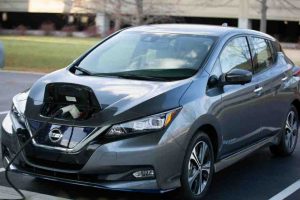
The Leaf’s charge port is smartly located under a panel in the center-front of the car, which echoes the practice in the distant past of installing the gas door behind the license plate in the center of the rear bumper of cars – which made it a snap to fuel at either the right or the left pump.
It also had four plugs inside – for your USB-powered devices – which is similarly convenient.
The Rest
Another thing to keep in mind – and it applies to any EV – is that if you regularly use up all or most of the battery pack’s range, you will likely have to replace the battery pack sooner. Heavy discharge/recharge cycles (especially at “fast” chargers) will inevitably reduce the battery’s useful service life by reducing its capacity to take and retain a full charge. 
What’s implicit in that is another, subtle EV problem. If you regularly use the advertised range, you are likely to get less life – out of the battery. The way to reduce the wear and tear on the battery (so as to lengthen its life) is to not discharge the battery heavily – by reducing the range you actually drive the EV.
The Bottom Line
The Leaf is now more affordable – but it’s still a very expensive way to not go very far.
. . .
Got a question about cars, bikes, Libertarian politics – or anything else? Click on the “ask Eric” link and send ’em in! Or email me at EPeters952@yahoo.com if the @!** “ask Eric” button doesn’t work!
If you like what you’ve found here please consider supporting EPautos.
We depend on you to keep the wheels turning!
Our donate button is here.
If you prefer not to use PayPal, our mailing address is:
EPautos
721 Hummingbird Lane SE
Copper Hill, VA 24079
PS: Get an EPautos magnet or sticker or coaster in return for a $20 or more one-time donation or a $10 or more monthly recurring donation. (Please be sure to tell us you want a magnet or sticker or coaster – and also, provide an address, so we know where to mail the thing!)
My eBook about car buying (new and used) is also available for your favorite price – free! Click here. If that fails, email me at EPeters952@yahoo.com and I will send you a copy directly!


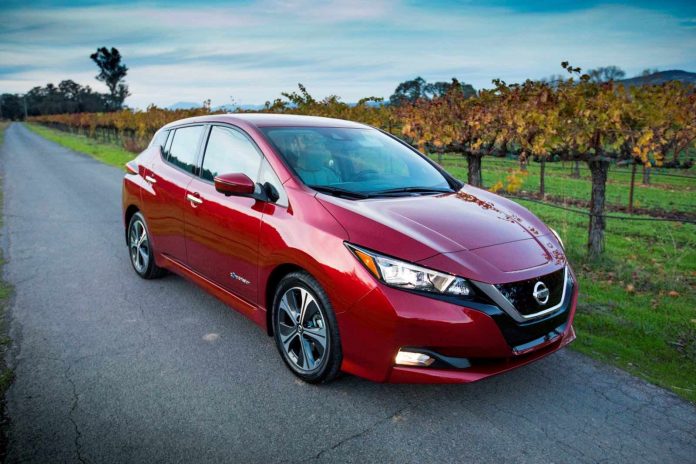

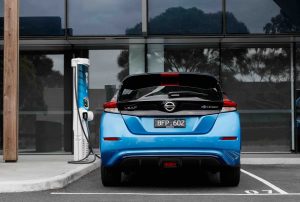









Still overpriced!! This is a under $20,000 car and with only a 149 mile optimum range,it should be a $10,000 throwaway car!
For $30,000 you can buy a midsize fully loaded car and upper 30’s a fullsize car with a V8 but I guess this is not who buys Nissan Leafs but just saying..
Hi Mark,
Yup. It’s demented. Other than the Leaf being electric, what makes it desirable? It is much more expensive than a non-electric equivalent that can be driven twice as far and is likely to last twice as long and which will retain the ability to travel as far as it could travel when it was new when it is 10, 15 even 20 years old. No EV can tout that.
The Leaf isn’t even quick.
So what’s the point?
What a one sided review. As a Nissan Leaf owner and an old petrol head who spent his life repairing and retuning and servicing petrol engines I am very very happy with the Nissan Leaf. It just needs to be used in the correct way. EVs are not the end of future transport development but they are a step in the right direction. This review and comment pay no head to the future, get over it.
Methinks people are overlooking one important advantage, you do not have to change the oil in the thing,I use the heck out of my cordless tools and I would say I get years of life out of them. It would be so much fun trying to keep 2 cycle skil saws, cordless drills .impact wrenches going and I tell you one thing after the years of breathing diesel and 2 cycle exhaust,I wouldn’t have missed the experience.
Its a funny thing, I walked by a well off acquaintnces TDI one day almost new( I thought-WTF? that thing smells like an old diesel, later I learned why.
This is not to say Diesels will not be around for a long time,Caterpillar is or has made Diesel Hybrid( hydraulic not electric) equipment that would cut fuel consumption 25%{excavators for this example} I have to think the “super movers” Diesel rigs will be around a long time,CAT had a 323 excavator (electric) that would go for 6 hrs- not bad , weight is not much of an issue in construction equipment and you didn’t have to fiddle with emission thingys.
Each will have its place, the market will sort it out,I must admit I am not wholly convinced about Tesla’s ESemi( vaporware as of yet)
I was thinking about EV viability earlier, and though I know I’ve made similar commentary in the past, I’ve come up with this: EVs won’t be widely successful (barring gov’t intervention) until their cost competes with the cost of gasoline for your typical new car for the lifetime of the battery.
Say the battery lasts 5 years, which is conservative. I will use arbitrary numbers, but I’ll say the average daily drive is 30 miles during the week, and 50 miles for the weekend (from my experience). Also $3 gas, being a little optimistic, these days, and a 30 MPG ICE car.
5 years * 52 weeks * 200 miles = 52,000 miles/30 MPG = 1733.33 gallons * $3/gallon = $5,200
So, given “free electricity” from solar or wind or some such, an electric car will have to be under $5,200 to be competitive. This is already possible in something like that $4,500 Chinese vehicle that Eric featured a few days back! They can throw in the charging equipment for $700.
This EV would be quite alright for city purposes. Shape it like an S10, and I might buy one for my rural land as well. Most days out there, I won’t be driving much more than 10 miles, so basically float charging and thus the battery would last much longer. Even driving 30 miles a day on a “100 mile battery” isn’t a deep discharge, and given regenerative braking, would be even less of a strain. The battery might actually last more like 10 years.
Nissan Leaf: Not quite there yet. :p
If the cheapest EV isn’t very practical, and the more practical models are the cost of normal cars that are still superior in practicality, what is the possible benefit to buying one?
Virtue signaling is all I can think, unless one lives on a golf course.
Eric – how did it get to you? You mentioned once you were too far to get an electric car without an overnight stay for a charge !
I have to wonder, regarding cargo area of the Versa vs. the Leaf, is that why can’t they just make the hatchback version of the Versa (the “Note”) like they used to, which would have similar cargo room as the Leaf? The hatchback is just a different body style than the sedan, with everything else being the same, so I can’t think of a reason why a hatchback should cost much different than the sedan
Hi Dood,
My 50 cents: The old Versa hatchback (no longer available) was too much parallel competition for the Leaf. So it had to go. Just like the entire roster of VW’s TDI-powered cars.
Off topic:
I would never buy an EV for the reasons you stated such as street parking and cold weather. Otherwise the EV might make sense for my driving range.
Do you get anything for a car recommendation? I bought the strippo (not even the 200.00 floor mats) Camry based upon your review. There are no manual gearboxes anymore so it is a slushpump. What you found to be desirable such as being able to see out of it and the lack of pushbutton start in the cheapest model pushed me. Once the goomint gloms on tax, title and fees it is not such a great deal.
I would not have considered the car without your review so do I credit you some way?
Considering that it is a fully electric car, the Nissan Leaf has one benefit, namely that it is reasonably priced for what it delivers and compared to other electric cars.
I own a Leaf, which is heavily subsidized in Norway. This car is reliable, the batteries have not degraded unexpectedly much and it is reasonably well technically built.
Besides from the above mentioned, I would probably not have bought another fully electric car, were they not heavily subsidized compared to hybrid or light hybrid cars.
Hi Jone,
Yes, but how about priced compared with non-electric cars? It astounds me that people don’t see this – or ignore it. How they passively sigh and just accept a doubling of the cost of a basic car.
As a rule the Norwegian people love government and anything it says. They love high taxes and $15.00 coffee and $20 12 oz beer
If you want throttle response get a super 7, 1200 lb. even with only 150 hp NA engine they have instant throttle response because of their light weight, with an aggressive diff. they will beat most cars through an intersection, some have 200,300, even 400 hp or more, like an old F2 car for the street.
A Donkervoort a Super 7 clone in 2003, 2004 had the world record lap time for any street legal car on the Nurburgring.
Dutton Super 7 clone with SBC V8 434ci, 1600 lb, steel tube frame, fibreglass body, it has run a best 8.90 sec 1/4 mile, this is how a car should be, small, light, agile, fast, no frills, mechanical art made to go fast only, no luxury, no doors or roof, some have no windshield, nothing extra, it is quicker then all the hypercars and the tesla plaid…… forget EV’s……
https://www.youtube.com/watch?v=Vn2lHb7N3uQ
I agree, Anon –
Weight is the killer. One could design a car capable of 5 second 0-60 runs and 60 MPG. It would just need to be light. Would it be “safe”? That depends on how one defines that. I define “safe” as something that if used for its stated purpose will do the thing it was designed to do without causing the user injury. If the user uses it irresponsibly or incompetently and is harmed as a result, the device is not “unsafe.”
People often equate “safe” with “crashworthy.” But the latter is not an objective criteria. A new Toyota Corolla is less crashworthy than a 10-year-old Mercedes S-Class, which would be labeled “unsafe” according to current standards.
To me, a safe car is one that is neither unstable, unpredictable or defective in its design in some way that could result in loss of control. Whether it can be driven into an oak tree at 50 MPH without its occupants being killed is a measure of something else.
Hi Eric
A Caterham would make an interesting test drive, there might be a dealer near you somewhere, a super 7 is a completely different driving experience, anyone that likes sports cars should try one, before they are made illegal.
https://www.youtube.com/watch?v=7MEL1aLpIGg
Hi Eric
A super 7 is one of the most agile cars, changes direction like nothing else, with instant throttle response and light weight it can avoid the huge overweight vehicles on the roads, the tube frame construction is strong, they handle well because they are low, stiff and light.
HKT is a great super 7 clone, one of the quickest street cars on the planet
https://www.youtube.com/watch?v=lBrzpayx-zw
anon 1
the leaf is air cooled like an old VW beetle……
no liquid cooling system reduces cost, weight, maybe less maintenance, simpler might be better…..
https://insideevs.com/news/482245/nissan-leaf-repair-liquid-cooling-benefits/
I dunno, I could almost see something like this as a second car. In my advancing years, I don’t drive much anymore. Grocery store a couple times a week, barber shop every other week occasional doctor/dentist appointments and so on. Any longer trips we take the wife’s car. I have a garage, so it’d be no big deal to plug it in when not in use. Do they make economic sense? Probably not, but then again I’ve spent money on lots of stupid shit in my life, especially when it comes to cars! I don’t think EV’s are a real long term solution, but under certain circumstances they could be a viable alternative. And hey, things don’t always have to make economic sense. That Triumph spitfire that I bought as toy a few years back was a real waste of cash (just ask my wife, she’ll tell ya all about it), but is was fun while it lasted.
Hi Floriduh,
I look at this thing and then look at a Versa – or a Kicks – either of which cost about half as much and then ask… why would I choose to spend that much more for the sake of . . . what, exactly?
It’s electric. Ok. Does that provide an advantage to me that’s worth spending $27k rather than $14k? Is the Leaf more convenient? I don’t see how. I know it doesn’t seem like much to plug in an EV at home, but it’s one of those little things that adds up when you have to remember to do it every day.
Come home, plug it in. Getting ready to go? Unplug. Watch out for that cord; it’s a trip hazard unless you roll it out of the way. One more thing to think about/do.
If you got the Versa, you just go. Come back. Park, go in. No cord, no having to remember to plug it in- or unplug it.
Maybe once a week you have to stop for the 5 minutes it takes to fill the tank.
It’s be even easier to make this choice if the Versa had a manual – which you can get – and so was at least some fun to drive. The Leaf is as fun to drive as Mrs. Doubtfire.
So you actually got to drive one, but I’m guessing by lack of a “rant” you didn’t get it for the week? Did you get to experience the back-in-the-seat acceleration and “stop on a dime” regenerative braking?
Wondering that too. Did they ship you one, or did you go somewhere for a shorter test drive?
My parents 1999 Jeep Grand Cherokee the owned form 99-12 with the 4.7 is quicker than a Nissan Leaf!
I guess you never drove a powerful vehicle…once you experience 4 seconds and quicker you will understand…88 mph in a 1/4 mile is nothing try 133 mph in the 1/4 mile then we will talk…My 1977 Aspen Station Wagon did 91mph in the 1/4 mile I had at 16 lol,was a great car though..
Furthermore 1980’s Turbo Dodge Omni’s are quicker than a Leaf..I owned a pair of them bone stock it ran high 14’s and very 15’s and low to mid 14’s and quicker depending on traction with the GLH-S,there were 6 others at my local track in the 1990’s and the stock ones ran the same as mine..Also a 1992 Honda CRX is tied with a leaf….So,back in the seat acceleration in a Leaf is laughable! Yes you feel the torque thats what you feel and traction off the line,like a 8000 lb Diesel truck feels quicker than it is because of the torque that presses your cheeks!
Yes,I owned a 1985 Omni GLH Turbo and another 1986 GLH-S and a 1992 Honda CRX si in the 1990’s and took them to the track,I worked at Honda so thought I would buy one..I have the slips packed away(I moved 3 months ago) low priority boxes didnt get unpacked yet.. I owned 6 cars at the same time,still do and more!
As for the brakes,get a old car with low gears and you rarely need to use the brakes to slowdown..Modern cars with 8,9,10 speed transmissions do a fine job at slowing themselves down to without the brakes…
As for the regenerative braking,it doesn’t give you many miles extra…I drove/owned a few Tesla’s and other electric cars for several thousand miles,as a car dealer I drove them all..Even a Leaf,I think I bought 4 so far..I guess quick for a small compact that gas models need the higher trim and upgraded engine to have the same performance as the Twig I mean Leaf….I owned them for my dealer not personal..
***I carried on about the older cars just to show you old compacts had the same or quicker performance times even old wagons and suvs…So,the performance is nothing to brag about nothing new for a car,especially a very expensive compact car!
Again does a 75 year old Granny need a performance car or a 16 year old? NO!! I love performance but not everyone needs a performance car(meaning 5 seconds or quicker car)..That seems to be the factor in making people want electric cars is performance…I also had a car the ran low 13’s in the 1/4 mile at 16,it got me in a lot of trouble!! Thus the wagon became my daily..I had to prove I wouldnt kill myself or others in my other car.
NOW….Just wait until Government limits your electric car as they have full control of it,easily be bricked if you speed or you never paid your road usage fee! Even limit you on speed and acceleration you have! There is a whole reason why people are against electric crap boxes of all makes! 0-60,1/4 mile wont matter when the government limits you to 15-40 mph in the City and it will take 25 seconds to reach 40 mph in your electric car as the Government controls it…They are hooked to the internet etc so its not your car,you just ride and pay for it..